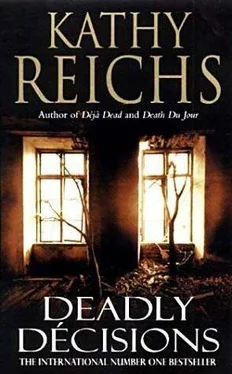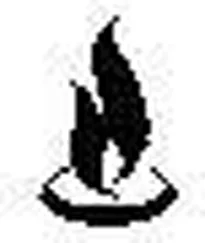When I mentioned the photos, she started at my voice.
"I'm on it," she said, sliding from her stool.
Weird one, I thought as I headed back to work on the Gately and Martineau reports.
Jocelyn brought me the dossiers within an hour, and I spent the next three going through them. In all, I'd worked on six headless women. Only two had lacked both thigh bones, and neither was young enough to be the girl in the pit.
From the years before I'd arrived in Montreal, seven female skeletons without crania remained unidentified. Two were young enough, but the descriptions of the remains were vague, and without skeletal inventories there was no way to know what bones had been recovered. Neither folder contained photographs.
I went back to the computer and checked the disposition of the earliest case. The bones had been held five years, rephotographed, then released for burial or destruction.
But the file contained no pictures. That was odd.
I asked for site of recovery. The bones had come in from Salluit, a village around twelve hundred miles north on the tip of the Ungava Peninsula.
I entered the more recent LML number and asked for site of recovery.
Ste-Julie. My pulse quickened. That was not twelve miles from St-Basile -le-Grand.
Ally McBeal's therapist was right. I needed a theme song for times when I felt stressed.
Runnin' down the road tryin' to loosen my load Got a world of trouble on my mind…
Maybe.
Slow down, you move too fast. Got to make the morning last…
As I reached for the sandwich an image of Saturday night's grotesque offering flashed across my mind. Again my skin went cold and prickly
Forget it. It could be a pig's eye. Your picture was in the paper, and any moron could have stuck it on the car for laughs. If anyone is out there watching, it's some twisted nitwit without a life.
I am woman watch me-
Definitely no.
It's a beautiful day in the neighborhood…
Oh boy
Game plan. Finish the reports on Gately and Martineau, finalize those on the Vaillancourt twins. Talk to Claudel. Based on his report, CPIC, then NCIC.
Life is under control. This is my job. There is no reason to feel stressed.
That thought had hardly materialized when the phone rang, destroying the calm I had worked so hard to achieve.
A female voice said, "I have a call from Mr. Crease, hold, please."
Before I could stop her he was on the line. "I hope you don't mind my calling you at work." I did, but held my tongue.
"I just wanted to say that I really enjoyed Saturday night, and hoped the two of us might get together."
Original.
"Would you be free to have supper some night this week?" "I'm sorry but that's not possible right now. I'm really swamped." I could be free until the end of the next millennium and I wouldn't dine with Lyle Crease. The man was too glib for my taste. "Next week?"
"No, I don't think so."
"I understand. Can I have your nephew as a consolation prize?"
"What?"
"Kit. He's a fabulous kid." Fabulous?
"I have a friend who owns a motorcycle shop. He must stock five thousand items of Harley-Davidson paraphernalia. I think Kit would find it interesting."
The last thing I wanted was my impressionable young nephew under the influence of a media smoothie. But I had to agree, Kit would enjoy it.
"I'm sure he would."
"Then it's cool with you if I give him a call?"
"Sure." Cool as dysentery~
Five minutes after I hung up Quickwater appeared at my door. He gave me his usual stony stare, then flipped a folder onto my desk.
I really needed to settle on a theme song.
"What are these?"
"Forms."
"For me to fill out?"
Quickwater was preparing to ignore my question when his partner joined us.
"I take it this means you came up empty.
"As Al Capone's vault," Claudel replied. "Not a single match. Not even close."
He gestured at the packet on my desk.
"If you get the papers filled out, I can access CPIC while Martin does NCIC. Bergeron's working on the dental descriptors."
CPIC is the acronym for the Canadian Police Information Centre, NCIC for the National Crime Information Center operated by the FBI. Each is a national electronic database providing quick access to information crucial to law enforcement. Though I'd used CPIC a few times, I was much more familiar with the American system.
NCIC first went on line in 1967 with data on stolen autos, license plates, guns, and property, and on wanted persons and fugitives. Over the years more files were added, and the original ten databases expanded to seventeen, including the interstate identification index, the U.S. Secret Service protective files, the foreign fugitive file, the violent gangs/terrorist file, and files on missing and unidentified persons.
The NCIC computer is located in Clarksburg, West Virginia, with connecting terminals in police departments and sheriffs' offices throughout the United States, Canada, Puerto Rico, and the U.S. Virgin Islands. Entries can be made only by law enforcement personnel. And they definitely make them. In its first year NCIC recorded two million transactions. It currently handles that many each day.
The NCIC missing persons file, created in 1975, is used to locate individuals who are not "wanted," but whose whereabouts are unknown. A record can be entered for missing juveniles, and for people who are disabled or endangered. Victims of abduction and those who have disappeared following a disaster also qualify. A form is completed by the missing person's parent or guardian, physician, dentist, and optician, and entered by a local department.
The unidentified persons file was added in 1983 to provide a way to cross-reference recovered remains against missing persons records. Entry into the system is permitted for unidentified bodies and body parts, for living persons, and for catastrophe victims.
It was this packet that Quickwater had tossed onto my desk.
"If you'll fill out the NCIC form we can work both networks. It's basically the same data, lust different coding systems. How long will you need?"
"Give me an hour." With only three bones I'd have little to say.
As soon as they left I began working my way through the form, periodically checking the data collection entry guide for codes.
I checked the box for EUD for unidentified deceased.
I placed an "5" in boxes 1, 9, and 10 of the body pans diagram, indicating that a skeletonized head and right and left upper leg bones had been recovered, All others boxes got an "N" for not recovered.
I marked "F" for female, "W" for white, and wrote in the approximate height range. I left empty the space for estimated year of birth and estimated date of death.
In the personal descriptors section I wrote SHUNT CERB, for cerebral ventricular shunt, and checked that item on the supplemental form. That was it. No fractures, deformities, tattoos, moles, or scars.
Since I hadn't any clothing, jewelry, eyeglasses, fingerprints, blood type, or information as to cause of death, the rest of the document remained blank. All I could add were a few comments about where the body was found.
I was completing the sections on agency name and case number when Quickwater reappeared. I handed him the form. He took it, nodded, and left without a word.
What was it with this guy?
An image flicked through my mind and was gone. A bloated eyeball in a jelly jar.
Q uickwater?
No way. Nevertheless, I decided to make no mention of the incident to Claudel or his Carcajou partner I might have asked Ryan, might have turned to him for advice, but Ryan was gone and I was on my own.
I completed the Gately and Martineau reports and walked them to the secretarial office. When I returned, Claudel was seated in my office, a computer printout in his hand.
Читать дальше








